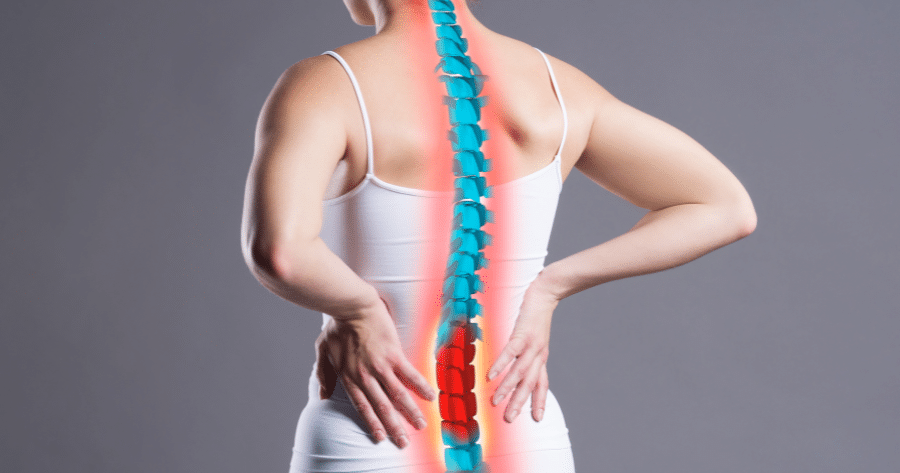Lumbar Spinal Stenosis Specialist in Chicago, IL
What is Lumbar Stenosis?

Lumbar stenosis is a spinal condition that occurs when the spinal canal in the lower back narrows, leading to compression of the spinal nerves. This compression can cause pain, numbness, and weakness in the lower back, buttocks, and legs. It is one of the most common causes of back pain in older adults and can significantly impact mobility and quality of life.
The narrowing of the spinal canal does not always result in symptoms, but individuals may experience discomfort while standing or walking for prolonged periods as it progresses. Sitting or leaning forward often relieves the condition, reducing pressure on the affected nerves.
What’s Causing My Back and Neck Pain?
The most common cause of lumbar stenosis is degenerative changes in the spine due to aging. Over time, the wear and tear on spinal structures can lead to conditions such as:
- Osteoarthritis: The gradual breakdown of cartilage in the spinal joints can lead to bone spur formation, which narrows the spinal canal.
- Herniated Discs: The soft material inside the spinal discs can protrude and press on spinal nerves, contributing to stenosis.
- Thickened Ligaments: Ligaments that support the spine can become stiff and thick over time, reducing the space available for nerves.
- Spinal Injuries: Trauma or previous spinal surgeries can lead to scar tissue formation, further narrowing the spinal canal.
- Congenital Factors: Some individuals are born with a naturally narrow spinal canal, which makes them more susceptible to developing symptoms earlier in life.
What Are the Symptoms of Lumbar Stenosis?

Symptoms of lumbar stenosis typically develop gradually and tend to worsen over time. Common signs include persistent pain in the lower back that may radiate into the buttocks and legs, and cramping or tingling sensations in the legs, especially after standing or walking for extended periods. Due to muscle weakness, individuals may also experience difficulty walking, climbing stairs, or maintaining balance. Symptoms often improve when bending forward, such as while using a shopping cart or sitting.
If lumbar stenosis leads to significant nerve compression, it can cause problems with bladder or bowel function, which requires immediate medical attention.
How is Lumbar Stenosis Diagnosed?
Your Suburban Orthopaedics provider will review your medical history and conduct a thorough physical examination. Imaging tests are crucial for visualizing spinal structures. X-rays are used to identify changes in the bone structure of the spine. Magnetic Resonance Imaging (MRI) provides detailed images of soft tissues, including nerves and intervertebral discs. Computed Tomography (CT) scans, often performed with contrast dye, can highlight areas of nerve compression.
How is Lumbar Stenosis Treated?
Treatment for lumbar stenosis varies depending on the severity of the symptoms. Mild cases can often be managed with conservative therapies, while severe cases may require surgical intervention.
Non-Surgical Treatments for Lumbar Stenosis
Treatment for lumbar stenosis often involves a combination of approaches, decided between you, the patient, and your orthopedic specialist. Physical therapy is crucial in treating lumbar stenosis, focusing on exercises designed to strengthen core muscles, enhance flexibility, and reduce pain.
Medications, such as over-the-counter nonsteroidal anti-inflammatory drugs (NSAIDs) or prescribed pain relievers, are frequently used to manage discomfort. Epidural steroid injections, which deliver corticosteroids directly to the affected area, can help reduce inflammation and nerve irritation. Furthermore, activity modifications involving adjustments to daily routines to minimize strain on the lower back are essential. In some instances, bracing may be recommended to provide additional support and alleviate pressure on the spine.
Surgical Treatments for Lumbar Stenosis
When conservative treatments prove ineffective in alleviating the symptoms of lumbar stenosis, surgical intervention may be considered. Standard surgical procedures include laminectomy, which involves removing a portion of the vertebra to create additional space for the spinal cord and nerves. Spinal fusion, another option, joins two or more vertebrae together to stabilize the spine and reduce pain.
When Should You See a Doctor for Lumbar Stenosis?
If you experience persistent lower back pain, numbness, or weakness in your legs that affects daily activities, it is essential to seek medical attention. Immediate medical care is necessary if you have severe pain, difficulty walking, or loss of bladder or bowel control.
Lumbar Stenosis Treatment at Suburban Orthopaedics
Lumbar stenosis is a progressive condition that impacts mobility and quality of life. While many cases can be managed with non-surgical treatments, advanced cases may require surgical intervention. If you suspect you have lumbar stenosis, schedule an appointment at Suburban Orthopaedics.
Request an Appointment
At Suburban Orthopaedics, our providers are here to help you. Set up an appointment today.